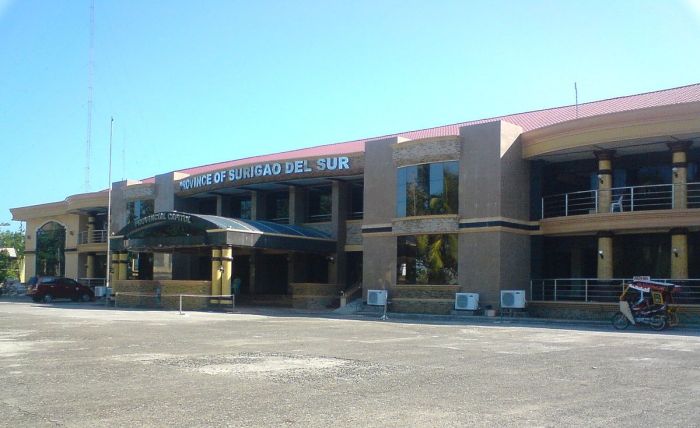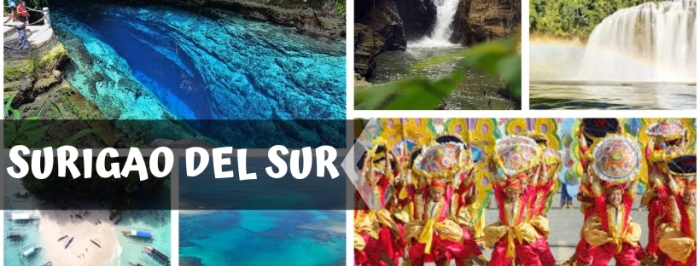Surigao del Sur (Surigaonon: Probinsya nan Surigao del Sur; Cebuano: Habagatang Surigao) is a province in the Philippines located in the Caraga region in Mindanao. Its capital is Tandag City. Surigao del Sur is situated at the eastern coast of Mindanao and faces the Philippine Sea to the east.


Surigao is a former province of the Philippines. Originally a Spanish-era district, became a chartered province on May 15, 1901. The province was dissolved on 1960, comprising what are now the provinces of Surigao del Norte, Surigao del Sur, and Dinagat Islands.
There are two hypotheses on the original meaning of “Surigao” among linguists, depending on the original root word. If the root word was taken to be sulig (“sprout” or “spring up”), then Surigao may have derived from suligao (“spring water”), likely referring to the Surigao River (known as “Suligaw” in Mandaya) that empties at the northern tip of the island of Mindanao. Early historical accounts record the name of the river as Suligao, Surigao, or Zurigan.
Another possibility is that it is derived from Visayan surogao or suyogao, meaning “water current”. From suyog (also sulog or surog), “current”; cf. Sinulog, Sulu, and Tausug (Suluk).
Surigao del Sur was created as the 56th Philippine province on June 19, 1960 through Republic Act 2786, separated from its mother province, Surigao, on September 18, 1960.
At the time of its inception, it was classified as 4th Class province with an annual income of over ₱300,000.00. Seven years later, because of rapid increase of revenue collection particularly from the logging ventures, it has been reclassified as Ist Class B and in 1980 as Ist Class A with an estimated annual income of around ₱13,000,000. It has been reclassified as 2nd Class with a revenue adding up to ₱315,888,300.63.
Recaredo B. Castillo was the appointed first governor and subsequently elected governor while Vicente L. Pimentel was the first elected congressman.
The province was formed with 13 municipalities. Six more were added, raising the number to 19 with Tandag as the capital. Two of its municipalities have been elevated to cities; the first was Bislig City. In 2007, Tandag was granted cityhood but it was nullified via a controversial decision by the Supreme Court a year later. In 2009, Tandag got back its city status after the court reversed its own ruling on December 22, 2009.
Surigao del Sur is located along the northeastern coast of Mindanao facing the Philippine Sea between 125°40′ to 126°20′ east longitudes and 7°55′ and 9°20′ north latitudes. It is bounded on the northwest by the province of Surigao del Norte, on the southeast by Davao Oriental, on the west and southwest by Agusan del Norte and Agusan del Sur.
Situated west is the Diwata Mountain Range, isolating the province from the rest of Mindanao. To the east lies the Philippine Sea. The Mindanao Deep, one of the deepest trenches in the world, is situated a few kilometers east of the coastline.
Land area
The land area of the province is 4,932.70 square kilometres (1,904.53 sq mi)[11] representing 27.75 percent of the total land area of Caraga Administrative Region and about 5.14 percent and 1.74 percent of the total land area of Mindanao and Philippines, respectively. The province is elongated in shape, extending from the northeastern portion at Carrascal to the southernmost municipality of Lingig. It is approximately 300 kilometres (190 mi) in length and 50 kilometres (31 mi) at its widest point which runs from Cagwait to San Miguel.
Climate
The province falls under Type II climate of the Philippines, characterized by rainfall distributed throughout the year, although there is a distinct rainy season which begins from the month of November and ends in March. However, the climatic behavior of the province for the past few years has shown variations wherein the onset of the rainy seasons no longer occurs on the usual time. Months with low rainfall are from July to October with September as the driest month. Wet months are from November to June with January as the wettest month.
Languages
Surigaonon and Tandaganon languages are spoken in most parts of Surigao del Sur (except in Bislig City and the towns of Barobo, Hinatuan, Lingig and Tagbina, where most of the inhabitants speak Cebuano and their native Kamayo, a different language but distantly related to Surigaonon, is spoken by the rest of the population), with Cantilangnon dialect, a northern variation of Surigaonon which is very much similar to the dialect of Surigaonon as spoken in Surigao del Norte, being spoken mostly in the five northern municipalities of the province namely Carrascal, Cantilan, Madrid, Carmen and Lanuza (or the municipal clusters called CarCanMadCarLan); these municipalities were once under a single Municipality of Cantilan before December 10, 1918. English is also widely spoken throughout the province.
Surigao del Sur is one of the suppliers of rice, bananas and other tropical fruits. Copper, chromite and silver are also found here. Marine and aquaculture is abundant in the province, being a primary livelihood of the inhabitants as the province is well known for producing seafood and sea by-products.
Mineral resources
Surigao del Sur is endowed with metallic minerals such as copper, gold, chromite, cobalt, nickel and lead zinc, as well as non-metallic (limestone, coal and feldspar, clay diatomite/bentomite and coarse/fine aggregates). There are small and large scale mining activities in the province. Corporations operating in a large scale are the Marc Ventures Mining Development Corporation at Carrascal and Cantilan, operating in an area of 4,799 hectares (47.99 km2) within the Diwata Mountain Range.[15][16] The CTP Construction and Mining Corporation, also in Carrascal, focuses on gold and nickel mining in an area of 35.64 square kilometres (13.76 sq mi) and 48.6916 square kilometres (18.80 sq mi), respectively. The Carac-an Development Corporation, also in Carrascal, has an area of 506.3764 square kilometres (195.51 sq mi). Small scale mining activities are found in the municipalities of Barobo, Carmen and San Miguel.
